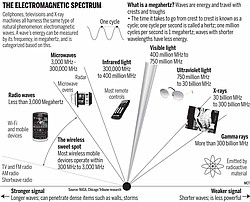Wireless carriers facing spectrum shortage
Dallas Morning News
DALLAS
Almost every wireless gadget on the planet, from the lock button on your car keys to the iPhone in your pocket to the Wi-Fi in your favorite coffee shop, runs over the electromagnetic spectrum.
And those invisible signals are worth tens of billions of dollars to companies such as AT&T Inc. and Verizon Wireless.
Dallas-based AT&T has cited the need for additional spectrum as one of the main reasons for its proposed $39 billion purchase of rival T-Mobile USA Inc.
“There’s just going to be a constant need for additional spectrum,” AT&T Chairman and Chief Executive Randall Stephenson said during a presentation after the deal was announced.
But what the heck is wireless spectrum?
And what does it mean that we’re facing a shortage of spectrum, or a “spectrum crunch,” as it’s been called by Federal Communications Commission Chairman Julius Genachowski?
Rewind to high-school physics class.
“You throw a pebble in a pond, and it creates these waves that go out,” said Dale Hatfield, former head of the office of engineering and technology at the FCC.
“It’s the same thing. When you move electric current in a wire, it creates a wave.”
And the more waves you pack into a given space, the higher the frequency.
Using those signals to communicate and send data is a process that dates back more than 100 years to the work done by Guglielmo Marconi and other inventors.
But we’ve come a long way from the simple dot-dash of wireless Morse code.
Now, wireless spectrum requires massive amounts of bandwidth for millions of different applications and users.
Though a multitude of devices use wireless spectrum — everything from old-school broadcast television stations to baby monitors to military missile guidance systems — the biggest growth is in the cellphone industry.
AT&T has noted that mobile data traffic on its network increased 8,000 percent in the past four years.
According to network-equipment maker Cisco Systems Inc., data traffic just on mobile networks last year was three times the amount of all data transmitted on the Internet in 2000.
For phones and other mobile devices, the most valuable wireless spectrum is in the frequency range of 300 megahertz to 3,000 megahertz.
Lower than that — down in the ranges where AM and FM radio operate — transmission towers get huge, and interference becomes a problem.
Higher than 3,000 megahertz — where radar systems and other devices operate — cellphone signals have trouble passing through even the flimsiest physical barriers.
“As you go to higher frequencies, the radio waves get more and more like light waves and can’t get through buildings,” said Hatfield, who is now executive director of the Silicon Flatirons Center for Law, Technology and Entrepreneurship at the University of Colorado-Boulder.
“They can’t even get through a leaf on a tree if you go too high.”
On every cell tower a wireless carrier builds to send out a signal to nearby phone users, the amount of spectrum is limited to the frequencies the carrier is licensed to use in that region.
Once too many users saturate the spectrum on that tower, signals fade and drop.
One solution is to build more towers.
Using the same slice of spectrum, you can connect more users by constructing more towers and keeping the number of users per tower low, since spectrum is reusable.
The wireless industry certainly has done that.
According to CTIA-The Wireless Association, a trade industry group, there were 253,086 cell sites at the end of 2010.
At the end of 2000, there were 104,288 towers.
But that solution is expensive and slow. You have to scout tower locations, secure building permits, spend money to build the towers, and lay copper or fiber-optic cables to each tower to connect them to the main network.
You also can use less-obtrusive short-range Wi-Fi networks to offload some of the mobile data load from your cell towers, or even offer users in-home mini cell towers, a technology known as femtocells.
Telecom analyst Roger Entner said that installing additional towers is a major engineering headache in its own right.
“Once cell sites become like 300 feet apart, it’s not really physically possible to split them further unless you get pico and femtocells,” he said. “It’s awfully complicated. Cell-site splitting is a real constraint.”
Carriers also can devise more-efficient ways to pack data on their existing spectrum.
Eventually, though, you simply need more spectrum.
“Demand for spectrum is rapidly outstripping supply,” Genachowski said in a recent speech.
“We need to tackle the looming spectrum crunch by dramatically increasing the new spectrum available for mobile broadband and the efficiency of its use.”
AT&T predicts that by 2015, it will transmit as much data over its wireless network every six weeks as it did in all of 2010.
“Even with more-efficient radio technologies, even with some of the capabilities that we traditionally have to stretch spectrum as far as we can get it to go, we can’t outrun the growth that’s in front of us,” said Bill Hogg, senior vice president of network planning and engineering for AT&T.
There were 78.2 million active smartphones in the U.S. at the end of 2010, up 57 percent from 49.8 million a year earlier, according to CTIA.
But if the wireless industry is going to get more spectrum, it’s going to have to come out of someone else’s spectrum piggybank.
Managing the allocation of spectrum for different commercial applications is the job of the FCC.
Copyright 2011 Associated Press. All rights reserved. This material may not be published, broadcast, rewritten, or redistributed.
 43
43

